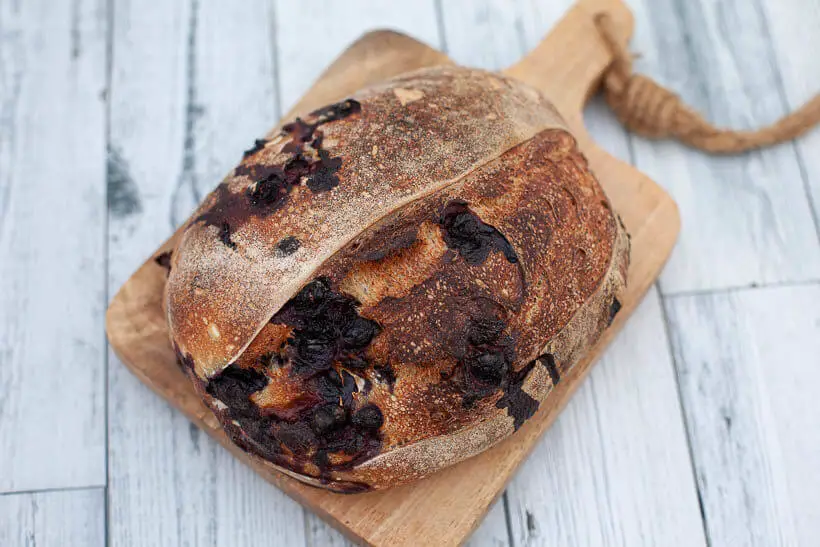It’s late summer here in Denmark, and the greengrocers and farmer’s markets are overflowing with ripe produce. There are berries of all kinds: strawberries, blueberries, raspberries, black and red currants, blackberries, and even more exotic ones like gooseberries and lingonberries. One of my absolute favorites is blueberries. This is my recipe for blueberry lemon sourdough bread.
I was inspired to make this recipe by one of my favorite breakfasts of all time: fluffy American blueberry pancakes. Well, the bread is not fluffy, but it does contain blueberries.
This recipe has been updated to be easier to make and follow. The video shows the older recipe. Both will give you an amazing and excellent bread.

This bread requires an active sourdough starter, you can easily make one by following my guide and recipe.
Are new to sourdough bread baking? There are quite a few techniques and lingo that you need to know and understand. If you haven’t baked one before, read my article about sourdough bread for beginners.
If you are just here for the recipe, you can press the button underneath to be automagically transported to the recipe:
Jump to Recipe Jump to VideoBlueberries
Blueberries are common in Europe, North America, and Asia, but the common commercially available kind has its roots in North America. This berry has a blue exterior and white flesh.
There’s a version of the berry (which is known as bilberry) that is native to Europe. This berry has darker blue-colored skin, and the flesh is deep red. We can sometimes get them at more specialized markets, but they are not easy to come by.

Both are really good, but I would say that the European version has a darker, more intense taste, akin to black currant.
Even though I bought some bilberries at my local market, I found that their skins were very brittle. I am sure that they would have popped while stretching and folding the dough. So, this bread should be made with the North American variety.
The formula in this blueberry lemon sourdough bread recipe
The vitals
| Total weight | 1688 grams |
| Pre-fermented flour | 9.1% |
| Hydration | 69.7% |
| Yield | 2 loaves |
The dough
The formula in this blueberry lemon sourdough bread is white bread with no whole grains. I chose this to get a softer and whiter crumb. The inspiration for this bread came from American blueberry pancakes, a favorite of mine.

The bread is 70% hydration and should be manageable by most bakers. The lack of whole grain does make it a bit slack. If you are worried about it being difficult, you can change the hydration to 65%.
| Weight | Ingredient | Baker's Percentage |
|---|---|---|
| 750g | bread flour | 100% |
| 500g | water | 66.7% |
| 18g | salt | 2.4% |
| 250g | blueberries | 33.3% |
| 20g | lemon zest | 2.7% |
| 150g | starter (100% hydration) | 20% |
As always, if you want to play around with the formula, change the hydration, or rescale it, you can find the formula here in my bread calculator.
Conclusion on this blueberry lemon sourdough bread recipe
Since the bread has no whole grain, it is white bread with a soft crumb. It is as soft as classic sourdough bread gets.
The crust is deeply caramelized and super crunchy. Whatever blueberries stuck out of the dough popped in the heat, giving the bread a gorgeous look.

The taste of sweet blueberries in the bread is great, and the lemon zest is fragrant and citrusy and stands up against the sweet blueberries.
It’s a bread that goes well with some wonderful butter or with anything you’d put jam on, so maybe a good piece of cheese.
I enjoyed it; it is not the last bread that enters my oven.
Please share this blueberry lemon sourdough bread recipe on social media
This is my recipe for blueberry lemon sourdough bread. I hope you will try to make it. If you make this recipe and post it to Instagram, please tag me as @foodgeek.dk so I can see it. That will make me very happy.
Ad links! Links for equipment and ingredients in this recipe are affiliate links, which means I will get a commission if you purchase the product!

Blueberry Lemon Sourdough Bread
Ingredients
- 750 g bread flour protein content 12-13%
- 500 g water
- 150 g sourdough starter fed and grown to its peak
- 18 g salt
- 250 g blueberries
- lemon zest from three lemons
Instructions
Mix the dough
- To a medium bowl, add bread flour, water, salt, sourdough starter, and the zest of three lemons. Mix the dough so that all of the flour has been hydrated.
- Cover the bowl and let it sit for one hour for the gluten to develop.
Stretch and folds
- Perform three sets of stretch and folds spaced out by 30 minutes.
- During the stretch and folds add a third of the blueberries.
- After the last set, put the dough in a proofing container and let it rise 25%.
Divide and preshape
- Put the dough onto your unfloured kitchen counter and divide it into two equally sized pieces of dough. Using your bench scraper, grab one piece and stretch each side (north, south, east, and west) out and over the dough.
- Flip the dough over and put the bench scraper behind it In one swift motion. Pull the dough forward so the top gets pulled down in front of the dough. If any blueberries pop out, pick them up and push them up underneath the dough.
- Once you can't get any further, put the bench scraper in front of the dough, push it away from you, and turn it around, so the bench scraper is behind the dough again. Keep going until you have a pretty taut surface. Continue with the other dough piece and let rest for 20 minutes.
- Prepare two oval bannetons by spritzing them lightly with water and flouring them with rice flour. When the dough has rested, sprinkle the top of the dough pieces with flour.
- Grab one dough ball and flip it over. Stretch the dough into a rectangle and fold the top corners towards the middle. Roll the dough towards yourself and press down lightly with your thumbs to seal the dough. Keep going until the loaf is oval.
- Flip the loaf into a banneton. I will often stitch the back of the loaf when it's in the banneton; that gives a bit more tension on the top of the bread. Continue with the other bread.
- Put both bannetons in the fridge for at least 8 hours, up to 48 hours.
Bake the bread – Next morning
- Add a dutch oven or a combo cooker to your oven—Preheat the oven to 230°C/450°F/Gas mark 8. Let the oven heat for 30 minutes.
- Grab a banneton from the fridge and flip the dough onto a peel with parchment paper. Score the bread, put it immediately into the dutch oven, and close it.
- Bake for 20 minutes with the lid on the dutch oven. After 20 minutes, remove the lid. Bake for another 25 minutes until the bread is deeply caramelized and crunchy.
- Take the bread out of the oven, and bake the other bread.











Excellent Recipe.
You put a lot of Time & Hard Work into this recipe. Thanks for your expertise…
Thank you 🙂
Here in Brasil we have dryed Blueberries (Mirtilo). May I use them? The same quantity?
As I don’t know them it’s hard for me to tell, but I would soak them before I put them in the bread. It sounds tasty 🙂
Use the same amount, but reconstituted. Not sure how much water they soak, but try it out with a little portion first to get an idea 🙂
Can I use frozen blueberries?
Yes, that would work fine 🙂
can we use frozen blueberry instead of fresh blueberry? thanks for the recipe.
Absolutely 🙂
Thanks for posting this recipe, Sune. I tried a variation substituting in dried cranberries and Orange zest for the blueberries and lemon zest. It created a fantastic loaf!
Love your content, keep creating!
Sounds delicious 😀 Love the creativity
Do we have to use parchment paper? I just ran out.
Nope. Make sure you put a lot of rice flour (or other gluten free flour) on the bottom of the bread before you turn it out of the banneton to score it 🙂
I did it with frozen blueberries, really nice way to do flavoured bread. Thank you!
Just made the first fold and added the blue berries and lemon zest. Would it be a good idea to fold in a tablespoon or 2 of honey to add sweetness? Love your recipes! Thanks
Sune,I made this recipe this week and it smelled Wonderful. It tasted Incredible and my granddaughters Loved it. Mine looks like yours on the outside but when I cut into the first loaf it wasn’t as pretty as yours, the second one was better. I always use an instant read thermometer to test for doneness and it was at 208° and 211° F, respectively. I’m wondering if I autolysed too long. I built my levain at 8:15 am and autolyse at 9 am. Levain was ready at 12:40 pm. I had trouble working the dough when I started to mix in the levain and salt.
Is 3.75 hours too long for the autolyse? Thanks so much
Made the blueberry lemon loaf. Fun to make and fantastic taste. Will definitely make this on the regular! Thanks!
Hi Sune your bread calculator for the blueberry bread doesn’t have the starter changed in the dough section like other recipes? When I change flour to make a bigger loaf I’m not sure how to increase starter… sorry to bother… amazing bread !!
I have not tasted the bread yet but I am beyond excited as to how they turned out!! My first time adding anything into a loaf. Beautiful loaves, easy to follow recipe!! Thank you!!
This came out just great. LOVED this recipe and flavor. Is there an easier way to zest 3 lemons? I ended up dicing little tiny bits of rind into the mix which worked well. I’m a relatively new baker – my hands were killing me. I have a zester that looks like a long thin paddle. I have shared this recipe with a few people – Thanks so much!
Hi Sune! I did a bench proof and baked when the poke sprung back slowly, but I ended up with a very hard to score dough and it sunk in the middle when baked. Any ideas?
Great bread. I’m adding it to my “go to” list for regular loaves to bake. This first time I didn’t wait the full hour to heat up the dutch oven and the first loaf came out just a bit doughy. Perhaps that’s why. I’ll do better next time. I like not having added sugar in the recipe – and it’s not needed. I could also like more lemon. I was afraid zest from three would be too much but I could still use more. What if some lemon juice in place of some of the water?
HELP! I weighed everything, followed the directions, but the dough is REALLY wet. I’ve added the lavain and salt. I was afraid to add the rest of the water. Can I add more flour at this step? I would hate to waste my beautiful blueberries and lemons.
Hi Sune,
Such a wonderful loaf.
My only issue was very large holes wherever the blueberries were in the loaf.
What may have caused this, and how do you think it can be avoided next time?
Thanks for all your teachings!
I just made this…. This is an amazing recipe. I wish I could show you how beautiful it came. Thank you so much for all the time and details in this recipe. It’s a keeper for sure. Will be making them for Valentine’s Day gifts.
How can you tell
When the dough has risen 25%?
Excited to try this! Is it possible to proof on the counter versus proofing in the fridge overnight? Not sure I could wait!
You can. It makes it a bit harder to tell when fermentation is done, and also to score the bread.
I’m confused about the lemon zest. You say to add 20g of zest at the beginning but then you say to add zest of three lemons later with the blueberries. My zest from three lemons was right around 20g. So we need six lemons worth? Or?
I haven’t made this yet because the video and recipe have different ingredient quantities and instructions. Wasn’t sure if you were aware of that since it’s confusing to know which recipe to follow. Maybe both work independently of each other?! Would love to know your preferred method before attempting this lovely bread! I greatly appreciate all of your inspiring work!
Hi Pamala,
At some point I updated the recipe to make it easier to make, but I didn’t write in the page that it was updated. Both will work, but the one written here is simpler.
Sune
Looks like a great recipe. Unfortunately I saw a local cottage bakery using your picture as their own on their menu masa.madre805